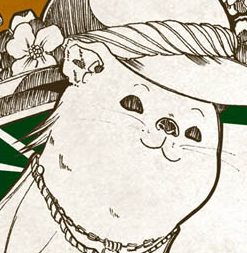
Activity 1
Week 2’s class activity was doing an exercise on shapes (Bauhaus drawing exercise?) and a 15-min portrait of a classmate!


Not sure what is going on with all the shapes.


We both drew Nisa!
And Nisa’s portrait of me-

She’s so good and fast it’s crazy (;u;)
Activity 2: Research on Self-Portraits and Artists!
Here are three artists whom I think are really inspirational and their insane self-portraits:
- Hirohiko Araki
- Jamie Hewlett
- Salvador Dali
1) Artist: Hirohiko Araki

Hirohiko Araki’s self portrait on his book “Hirohiko Araki’s Manga Techniques”
Famous for: Jojo’s Bizarre Adventure (Manga series running from 1987-present)
I started reading and watching Hirohiko Araki’s Jojo series recently at a friend’s recommendation. Hirohiko Araki’s work draws alot of inspiration from Sherlock Holmes, Renaissance sculptures, paintings and western music (such as Pink Floyd, Styx, Queen).
His self portrait features himself and a character in his series named Rohan. Hirohiko Araki drew many parallels between himself and this character – in interviews.
Compared to his usual works, his self-portrait on the book cover was surprisingly tame – just an image of himself embracing a character who’s most similar to himself.



Hirohiko Araki’s illustrations and a panel excerpt from his comic
Medium:
Traditional. (Nib pens and markers)
Color, Line, Texture:
In his works, he accentuates the facial features and is fond of designing complicated, impractical clothing. He’s not afraid to distort proportions and challenging constructs – frequently forgoing realistic colour choices for strong colours with more emotive qualities. In one of his books, he notes Paul Gauguin as one of his influences in his colour choice – one of the Fauvism influences.
The lines he uses are meticulous and he uses hatching techniques in emphasizing the strength of shadows and imply different tones in black-and-white pages, such as the features on the characters’ faces and in drapery. He casts more realistic shadows than stylized ones – making characters resemble Renaissance sculptures.
His mastery of line weight allows him to create a plethora of textures within the design of characters. The following is one example of different textures in the characters’ hairstyles:


What’s inspiring:
What I really took away from his work is the spirit of challenging perceptions with his art and it was very interesting to look into how he does research on the things he likes in order to work on comics, guidebooks and illustrations – and how these inspiration translates into elements within his art and turned into a distinctive visual style.
References:
Celebrating The Art and Fashion of Jojo’s Bizarre Adventure: https://www.animenewsnetwork.com/feature/2019-07-31/celebrating-the-art-and-fashion-of-jojo-bizarre-adventure/.149560
Jojo’s Araki Creates Manga for France’s Louvre Museum:
https://www.animenewsnetwork.com/news/2009-01-22/jojo-araki-creates-manga-for-france-louvre-museum
Gucci Windows Come To Life With Exclusive Manga: https://www.herworld.com/fashion/gucci-windows-come-life-exclusive-manga/
Vizmedia – Message from Hirohiko Araki – JoJo’s Bizarre Adventure and Fashion:
https://www.youtube.com/watch?v=r2FHRUjBI6Q
2) Artist: Jamie Hewlett

From Jamie Hewlett’s instagram – self portrait in 2018
Famous for: Tank Girl, Gorillaz


Medium: Traditional (ink, paints) and digital
Color, Line, Texture:
Jamie Hewlett’s self portrait consists of only two colors (blue and red) on a canvas and a giant smile. Blue is used for indicating skin tones and some features, while red is used to block out the background of the self portrait and used to indicate his spectacles and clothes (the inanimate items). The spaces left blank are left to indicate a light source coming from the left side.
The lines, compared to his usual works that feature a cleaner finish, are loose and messy. The lines are also marked in with the paints and creates alot of broken lines.
What’s inspiring:
From Hewlett’s portrait, it is reassuring to know that sometimes artists may take a completely different (or opposite) approach when it comes to their self-portraits! While it’s not as polished and as impressive as his usual works, Hewlett’s portrait reflects his frame of mind, insinuating that he’s having a good time and he’s being casual and experimental with his own portrait.
Reference:
Jamie Hewlett’s Instagram: https://www.instagram.com/hewll/
3) Artist: Salvador Dali

Soft Self-Portrait With Grilled Bacon (1941)
Famous for: Surrealist paintings, The Persistence of Memory
Medium: Traditional, oil on canvas
Color, Line, Texture:
The painting is a brown monochromatic colour scheme. There are no distinct strokes, favouring a more painterly style. The face is painted to be soft and almost gooey, as if melting, and the fork-like crutches are trying their best to hold up all the features (even the chin!) on the face so that they would stay as a recognizable face.
What’s inspiring: The self-portrait introduces an extra dimension of smell to go with the viewing experience! Most people have eaten grilled beacon and from the captioning of the self-portrait, we are able to recall the smell while viewing the image. This makes viewing the self-portrait extra interesting since we can not only experience what’s drawn but also what’s ‘not there’.
His painting also features multiple seemingly unrelated objects and elements in them to convey meaning and utilizes trompe-l’oeil (art technique to deceive the eye). There’s always alot to take apart in his works.
Reference:
Soft Self-Portrait with Grilled Bacon: https://www.salvador-dali.org/en/museums/dali-theatre-museum-in-figueres/the-collection/138/soft-self-portrait-with-grilled-bacon


